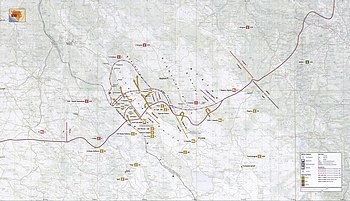Operation Winter '94
Operation Winter '94 was the first in a series of successful advances made by the HV and the HVO in or near the Livanjsko field, an elongated flat-bottomed valley surrounded by hills.The Croatian forces renewed their advance with Operation Leap 2 between 4 and 10 June, allowing them to directly threaten Bosansko Grahovo on the Drvar–Knin road, and to secure the remainder of the valley.The Yugoslav People's Army (Jugoslovenska Narodna Armija – JNA) confiscated Croatia's Territorial Defence (Teritorijalna obrana) weapons to minimize resistance.[1] On 17 August, the tensions escalated into an open revolt by Croatian Serbs,[2] centred on the predominantly Serb-populated areas of the Dalmatian hinterland around Knin,[3] parts of the Lika, Kordun, Banovina and eastern Croatia.Milošević, preferring a campaign to expand Serbia rather than preservation of Yugoslavia, publicly threatened to replace the JNA with a Serbian army and declared that he no longer recognized the authority of the federal Presidency.[11] On 8 October, Croatia declared independence from Yugoslavia,[12] and a month later the ZNG was renamed the Croatian Army (Hrvatska vojska – HV).[15][16] In January 1992, an agreement to implement the peace plan negotiated by UN special envoy Cyrus Vance was signed by Croatia, the JNA and the UN.[17] As a result, the United Nations Protection Force (UNPROFOR) deployed to maintain the ceasefire,[18] and the JNA was scheduled to retreat to Bosnia and Herzegovina, where further conflict was anticipated.[30] Formal establishment of these forces was preceded by the first armed clashes in the country as the Bosnian Serbs set up barricades in Sarajevo and elsewhere on 1 March and the situation rapidly escalated.[29] By the end of 1992, the VRS held 70% of Bosnia and Herzegovina,[33] following a large-scale campaign of conquest and ethnic cleansing backed by military and financial support from the Federal Republic of Yugoslavia.[42] In a meeting held on 29 November 1994, Croatian representatives proposed to attack Serb-held territory from Livno in Bosnia and Herzegovina to draw off part of the force besieging Bihać and prevent its capture by the Serbs.One hundred and thirty soldiers from the HV 126th Home Guard Regiment commanded by Brigadier Ante Kotromanović infiltrated behind VRS positions on the left flank of the front line[50] (head of the initial north-west advance along the Livanjsko field and Mount Dinara, with most of the HV troops commanded by Gotovina[52] against the VRS 9th Light Infantry Brigade.The civilian evacuation was nearly complete by 16 December; on that day valuables were removed from churches and monasteries in the VRS-held territory near the front line, although there was no immediate threat to them.[61] By spring 1995, relatively small shifts of the line of control west of the Livanjsko field enabled the VRS and the ARSK to threaten the HV positions on Dinara and Staretina mountains.[59] This one-day operation moved the front line—from which the VRS 9th Light Infantry Brigade had intermittently mounted attacks during the previous three months—north-west,[63] and put the HV within easy reach of Uništa—one of the few passes over Dinara.HVO troops took Crni Lug and the mountain pass en route to Bosansko Grahovo, the operation's chief objective.[67] Its left flank, in the border area, was protected by the 3rd Battalion of the 126th Home Guard Regiment and the Tactical Sniper Company attached to the HV Split Corps.[66] Operations Leap 1 and 2 improved the positions of the Croatian forces east and west of the Livanjsko field, and brought Bosansko Grahovo and Glamoč within striking distance.[54] The secondary objective of Operation Winter '94 was achieved more easily; the Croatian forces approached the Knin-Drvar road and directly threatened the main supply route between the Republika Srpska and the RSK capital.
Areas in Croatia controlled by:
ARSK , HV
Areas in Bosnia and Herzegovina controlled by:
VRS , ARSK , ARBiH , APWB
1 – Bihać, 2 – Cazin, 3 – Velika Kladuša, 4 – Bosanska Krupa, 5 – Bosanski Petrovac, 6 – Drvar, 7 – Sanski Most, 8 – Prijedor, 9 – Udbina, 10 – Korenica, 11 – Slunj, 12 – Vojnić, 13 – Glina, 14 – Dvor, 15 – Kostajnica, 16 – Petrinja, 17 – Sisak, 18 – Karlovac, 19 – Ogulin, 20 – Otočac, 21 – Gospić

Croatian War of IndependenceBosnian WarŠibenikGospićUdbinaBihaćBanja LukaKupresGrahovoGlamočMrkonjić GradŠipovoDrnišBenkovacUništaCroatiaBosnia and HerzegovinaHerzeg-BosniaRepublika SrpskaTihomir BlaškićJanko BobetkoAnte GotovinaRatko MladićCroatian ArmyCroatian Defence CouncilArmy of Republika SrpskaCroatian War of IndependencePakracPlitvice LakesBorovo SeloZadar riotSplit protestStingerHrvatska KostajnicaKijevoLabradorBanija villagesVukovarMassacreBrđaniOsijekPetrinjaKusonjeKorana bridgeThe BarracksVaraždinBjelovarJNA campaignDubrovnikCerićBanski DvoriŠiroka KulaBogdanovciErnestinovoBaćinSaborskoLibertas convoyPožegaSwath 10Dalmatian channels KostrićiŠkabrnjaAntunovacVance planWhirlwindPaulin DvorGornje JameOrkan 91VoćinJoševicaDevil's BeamBruškaVrsar airportSarajevoECMM helicopter downingBaranjaJackalMiljevci PlateauLiberated LandKonavleVlašticaMaslenicaMedak PocketAngelaLeap 1MedariZagrebLeap 2Summer '95KomićKijaniGolubićUzdoljeBosanski Petrovac bombingGruboriGošićMaestral 2VarivodeVukovar '95Timeline of all major eventsLog RevolutionEvents in SerbiaSarajevo JNA columnZvornikVišegradPrijedor cleansingTuzla JNA columnGalaja resistanceVrbas '92Corridor 92Majevica frontKorićani CliffsCroat–Bosniak WarMunja '93AzićiŽepčeKravicaŠtrpciTravnikMostarDeny FlightAhmićiTrusinaSovići/DoljaniDobrinjaBugojno